If you’re a hiker you’ve probably worn jeans while out on a hike. I know I have. But should you go hiking in jeans?
You can go hiking in jeans but it is one of the worst types of pants to go hiking in. Jeans lack breathability, have limited flexibility, and retain moisture. Plus, there are many better hiking pants options to choose from.
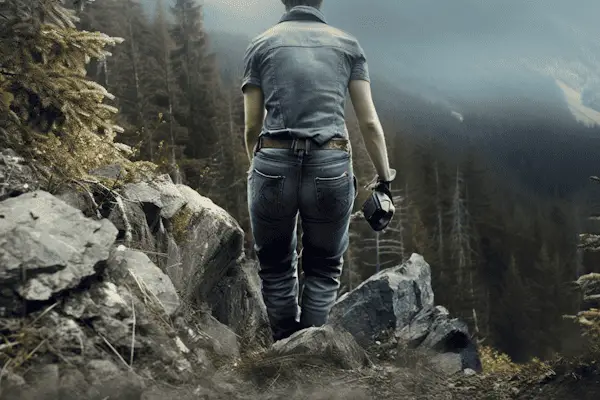
Why It’s a Bad Idea To Hike In Jeans
I understand how tempting it is to grab your most comfy pair of jeans for that spontaneous hike. You know, the pair you’ve worn in just right, the ones that seem to fit you like a second skin. The idea of spending time and money on specialized hiking gear might seem unnecessary. After all, jeans are sturdy, versatile, and hey, they can be pretty stylish too, right? They’ve been your trusty companion for so many different occasions, so why not for a hike?
But hold on a minute, let’s consider this carefully. As much as we love our denim for everyday casual wear, taking them out on the trail may not be the best idea. When it comes to hiking, there are unique challenges to consider. Traversing different terrains, dealing with changing weather conditions, the possibility of crossing a stream, and the sheer physical exertion – these are just a few things that can make your trusty jeans not so ideal. Let’s delve into the specifics of why jeans may not be your best hiking companion.
Jeans Are Too Stiff For Hiking
So, here’s the deal. Imagine you’re midway up a steep incline or trying to scramble over some rocky terrain. It’s at these moments that you need your legs to move freely, right? You’re not just strolling along a flat and paved path. This is the wild outdoors! It’s all about those big strides, high steps, and sometimes even a bit of a climb.
But then there you are in your trusty jeans, and suddenly they feel less like a second skin and more like a constraint. You know why? Jeans aren’t really designed for flexibility. They’re not made for those long strides or high steps. Their fabric, especially when it’s a traditional, non-stretchy kind of denim, doesn’t give you the freedom of movement you need for these kinds of activities. Plus, they can be pretty snug, particularly around the knee and hip areas, and that can further limit your range of motion. So when you’re hiking, your best bet is to wear something that’ll move with you, not against you.

Sweating in Denim? Not So Cool!
Let’s chat about breathability, or in simpler terms, let’s talk about sweat. Now, we all know that hiking isn’t exactly a walk in the park, pardon the pun. It’s going to get your heart rate up, your muscles working, and yes, it’s going to make you sweat. Sweating is completely natural and is our body’s way of cooling itself down. But here’s the catch, for this cooling system to work effectively, that sweat needs to evaporate.
Enter jeans, our trusty friends, but, alas, not the best at letting our sweat do its thing. You see, denim isn’t exactly known for its breathability. It tends to trap heat and moisture, rather than allowing it to escape. This can leave you feeling pretty sticky, hot, and uncomfortable, which isn’t exactly ideal for an enjoyable hike. Plus, if it’s a warm or humid day, this can just escalate the situation. Hiking gear, on the other hand, is usually designed to be breathable, to wick away sweat, and to keep you feeling as fresh as possible. So, in this aspect, your beloved jeans might fall short.
Wet Jeans? The Long-lasting Unwanted Souvenir
Picture this: you’re out there on the trail, the clouds roll in, and before you know it, you’re in the middle of an unexpected downpour. Or maybe you decide to cross a stream, and oops, it’s a bit deeper than you thought. Now you’re soaking wet. And if you’re wearing jeans? Well, you’re in for a long and uncomfortable experience.
Denim has a knack for holding onto water like it’s going out of style. It absorbs it quickly and then takes ages to dry out. The result? Your jeans become heavier, stick to your skin, and chafe like nobody’s business. In cold conditions, wet jeans can even pose a danger, because they can make you lose body heat faster, putting you at risk of hypothermia.
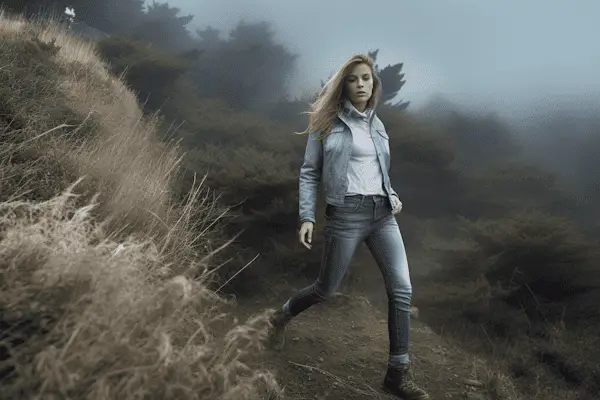
So if there’s even a remote possibility you might get wet, whether from rain, crossing water, or even just dewy vegetation, hiking in jeans is a definite no-go. Unlike denim, many materials used in proper hiking pants are treated to be water-resistant or even waterproof. Even when they do get wet, they dry out much faster, ensuring you stay as comfortable as possible on your adventure.
Chafing: Your Uninvited Hiking Companion
Alright, let’s get a bit personal here. Chafing. Not a fun topic, but it’s a pretty crucial one when it comes to hiking. This is the nasty reality of skin rubbing against skin or against clothing for extended periods. And let’s face it, hiking certainly involves a lot of extended periods of movement.
Now, consider your trusty pair of jeans. They’re often quite heavy, and their seams can be pretty thick. This, coupled with the fact that they can be quite tight in certain areas (I’m looking at you, thigh area), can lead to some serious chafing issues. And if they get wet, the problem just gets worse. Wet denim rubbing against your skin for hours on end? That’s a recipe for a whole lot of discomfort and potential skin irritation or even injury.
Hiking in something more lightweight, breathable, and designed to manage moisture can help to significantly reduce the risk of chafing. Because trust me, chafing is one hiking companion you definitely don’t want tagging along!
Hiking In Jeans Increases Your Weight
Think about it this way, when you’re hiking, everything you’re wearing or carrying is like a hitchhiker you’ve got to lug around. Every extra ounce feels like it’s having a party on your back, or in this case, on your legs. And as the miles add up, so does the impact of that weight. This is where jeans just don’t do us any favors.
Jeans, especially when made of thick, heavy-duty denim, can weigh quite a bit more than your typical pair of hiking pants or shorts. Now, you might think, “Well, what’s a little extra weight?” But in reality, over a long day of hiking, that “little extra” can feel like you’re hauling around a bag of rocks. It can make your legs tire out faster and can take some of the pep out of your step.
And remember our chat about getting wet? If your jeans get wet, they become even heavier. It’s like upgrading from carrying a bag of rocks to a bag of wet cement. On the other hand, hiking pants are typically designed to be as lightweight as possible, so they don’t hold you back from being your most adventurous self. So when you’re considering what to wear on your hike, remember, less weight equals less strain and more fun on the trails.
Jeans Aren’t Durable Enough For Hiking
Now, we all know that jeans are known for their durability, right? They’re the workhorses of the fashion world, able to withstand spills, stains, and all the rough and tumble of daily life. But when it comes to hiking, durability takes on a whole new meaning. You’re not just dealing with the occasional coffee spill or scraped knee here. We’re talking sharp rocks, prickly underbrush, and tree branches.
Despite their general toughness, jeans might not hold up as well as you’d hope in these conditions. Denim can easily snag on branches and tear on rocks, turning your stylish pair into patchwork before you know it. And remember, jeans are typically heavier and less flexible. If they rip, it can be more than just a fashion faux pas. It can actually limit your mobility.
In contrast, hiking pants are typically made from materials that are designed to withstand the great outdoors. Many are reinforced at common stress points, like the knees and seat, and some even have ripstop construction to prevent a small tear from turning into a big problem. So while jeans might be the champion of city living, when it comes to taking on Mother Nature, they might not be the best bet.
Jeans Aren’t Comfortable Enough For Hiking
Last but certainly not least, let’s talk about comfort. Because really, isn’t that one of the most important parts of enjoying your hike? You want to feel good, to move freely, to appreciate the beauty around you without being distracted by a pair of pants that are too tight, too hot, too heavy, or too wet.
And here’s where jeans might just drop the ball. Yes, they might be super comfy when you’re lounging at home or going out for a casual dinner. But out on the trail? That’s a whole different ball game. Hiking involves a lot of movement, in all sorts of conditions. As we’ve discussed, jeans can restrict your mobility, trap heat and moisture, and chafe, especially on longer hikes. They also don’t provide much cushioning if you’re clambering over rocks or sitting down for a break.
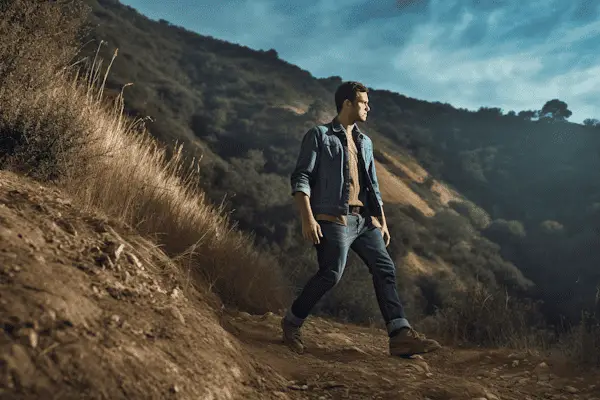
Hiking pants, on the other hand, are specifically designed to maximize comfort on the trail. They’re usually lightweight, flexible, and breathable, and many have features like gusseted crotches and articulated knees to make movement easier and more comfortable. Some even have padding in key areas, or adjustable waistbands for a perfect fit.
So when it comes to hiking, swapping your jeans for a pair of proper hiking pants can really ramp up your comfort level. After all, a comfy hiker is a happy hiker!
Alternatives To Hiking In Jeans
So, if you’re not going to wear jeans on your next hike, what should you wear?
Here are five jean alternatives to consider:
1. Standard Hiking Pants: The Trusty All-Rounder!
A great place to start is with standard hiking pants. Picture them as your trusty all-rounder, kind of like a Swiss Army knife in the form of pants!
Standard hiking pants are designed specifically with outdoor adventurers in mind. Lightweight? Check. Durable? You betcha. They’re usually made from synthetic materials like nylon or polyester that are hard-wearing and quick-drying. Unlike jeans, these fabrics are a dream when it comes to flexibility and breathability, letting you navigate that tricky terrain with ease and keeping you cool as you work up a sweat.
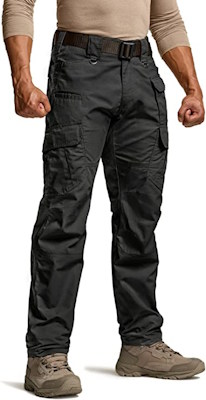
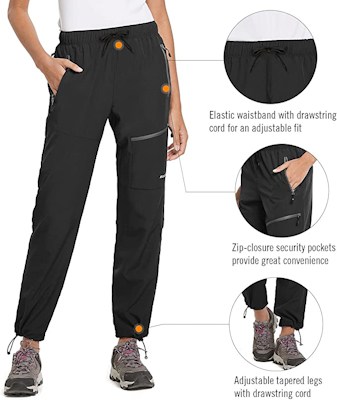
But the perks don’t stop there. Most hiking pants come loaded with practical features. You might find ones with cargo pockets perfect for stashing your map, trail snacks, or other essentials. Some even have built-in belts or adjustable waistbands for that perfect, comfortable fit. And let’s not forget about UPF ratings for added sun protection!
In a nutshell, standard hiking pants are designed to keep you comfy and focused on the trail ahead, instead of worrying about what you’re wearing. Now that’s a win!
2. Convertible Hiking Pants: The Master of Adaptability!
Now, what if I told you there’s a pair of pants that can adapt to changing weather conditions like a chameleon? Welcome to the wonderful world of convertible hiking pants! These are the real MVPs when it comes to versatility on the trail.
Convertible hiking pants are basically a two-in-one deal. They’re full-length pants when you need the protection or warmth, but when the sun’s blazing or you’re facing a strenuous uphill climb, you can easily zip off the lower sections, and voila – you’re in shorts!
This adaptability makes them a popular choice among hikers. They mean you can pack less and be prepared for a wider range of weather and trail conditions. Plus, just like standard hiking pants, they’re usually lightweight, durable, and come with a bunch of handy features like zippered pockets, adjustable waistbands, or even articulated knees for better mobility.
So, whether you’re facing a chilly morning start, a scorching midday climb, or crossing a knee-high stream, convertible hiking pants have got you covered. Or, well, uncovered, depending on the situation!
3. Hiking Leggings and Tights: Snug Fit, Maximum Flexibility!
Fancy bringing a touch of the yoga studio to the great outdoors? Let’s talk about hiking leggings or tights. They’re an excellent choice if you’re after a snug fit without compromising on flexibility. In fact, in the flexibility department, they’re pretty much unrivaled!
Hiking leggings hug your body, reducing any excess fabric that could get snagged on branches or undergrowth. This sleek design, coupled with the super stretchy materials used, means you’ll have complete freedom of movement. Whether you’re clambering over a fallen tree or stretching your stride to conquer a steep trail, hiking leggings move with you.
And don’t worry, while they might feel like your comfy yoga pants, they’re made to endure the demands of the trail. Many are made from quick-drying, sweat-wicking fabrics to keep you comfortable, even as you work up a sweat. Some offer handy features like side pockets for your essentials or reinforced panels for extra durability. So, if you’re looking for maximum comfort and flexibility on your hike, leggings or tights could be your perfect trail partner!
4. Softshell Pants: Your Shield Against the Elements!
So, you’ve checked the weather forecast and it’s not looking great. A bit chilly, maybe some drizzle, or even just a windy day. Does that mean you should cancel your hike? Heck no! That’s when softshell pants come to the rescue.
Softshell pants are like your personal shield against the elements. They’re typically water-resistant (if not fully waterproof) and wind-resistant, making them the perfect ally for hikes in cooler, wetter, or windier conditions. They help to protect you from the elements while also keeping you warm.
But don’t think these pants are some rigid, unyielding suit of armor. Quite the opposite! Softshell pants are known for their flexibility. Most are made from stretchy fabrics that move with you, making them both comfortable and practical for hiking.
Plus, they typically have a soft, slightly fleecy inner lining, adding a little bit of extra warmth and making them feel nice and cozy. Just like other hiking pants, they come with useful features like zippered pockets or adjustable waistbands. So, if you’re facing challenging weather on your hike, soft-shell pants can help you stay comfortable and enjoy your adventure!
5. Hiking Shorts: Breeze Through Those Hot Weather Hikes!
Got a sunny, hot weather hike on the cards? Then hiking shorts could be your best trail buddy! When the temperature rises and you’re dreaming of jumping in every stream you pass, a pair of lightweight, breathable hiking shorts can be a lifesaver.
Hiking shorts are like the breezy, laid-back cousin of hiking pants. They offer the ultimate in breathability and freedom of movement, perfect for those hot summer hikes or even tropical adventures. With shorts, your legs can get that sweet, cooling airflow, helping you to keep your cool as you tackle the trail.
Like all good hiking attire, hiking shorts are designed with practicality in mind. They’re typically made of quick-drying, durable materials and come equipped with useful features like pockets for stashing your essentials or adjustable waistbands for the perfect fit. Some even offer UPF protection to guard your thighs from the sun.
Just remember, while hiking shorts are fantastic for keeping cool, they do offer less protection against sun, bugs, and scratchy undergrowth than full-length pants. So be sure to consider your specific hiking conditions before opting for shorts. And don’t forget the sunscreen!
For more on what to wear hiking, check out my post titled, “What To Wear On A Day Hike“.
